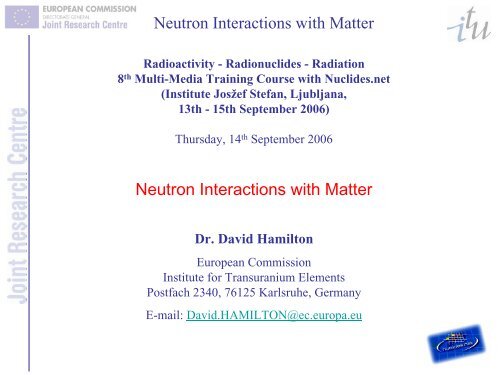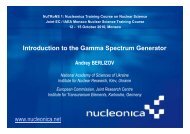Neutron Interactions with Matter - Nucleonica
Neutron Interactions with Matter - Nucleonica
Neutron Interactions with Matter - Nucleonica
You also want an ePaper? Increase the reach of your titles
YUMPU automatically turns print PDFs into web optimized ePapers that Google loves.
<strong>Neutron</strong> <strong>Interactions</strong> <strong>with</strong> <strong>Matter</strong><br />
Radioactivity - Radionuclides - Radiation<br />
8 th Multi-Media Training Course <strong>with</strong> Nuclides.net<br />
(Institute Josžef Stefan, Ljubljana,<br />
13th - 15th September 2006)<br />
Thursday, 14 th September 2006<br />
<strong>Neutron</strong> <strong>Interactions</strong> <strong>with</strong> <strong>Matter</strong><br />
Dr. David Hamilton<br />
European Commission<br />
Institute for Transuranium Elements<br />
Postfach 2340, 76125 Karlsruhe, Germany<br />
E-mail: David.HAMILTON@ec.europa.eu
<strong>Neutron</strong> <strong>Interactions</strong> <strong>with</strong> <strong>Matter</strong><br />
Why are <strong>Neutron</strong> <strong>Interactions</strong> Important?<br />
• Common sources of neutrons used in science and industry:<br />
– Nuclear reactors;<br />
– Nuclear fusion sources (D-T generators);<br />
– Accelerator-based sources (spallation);<br />
– Radioactive decay ( 252 Cf).<br />
• Also produced from other radiation<br />
types through secondary nuclear reactions.<br />
• Highly-penetrating, indirectly ionising radiation.<br />
• Can induce large radioactive doses through<br />
activation in the body.<br />
• Widely used in nuclear industry, material<br />
research, imaging, medical physics ...<br />
ATR, US DoE, Idaho National Lab
<strong>Neutron</strong> <strong>Interactions</strong> <strong>with</strong> <strong>Matter</strong><br />
The <strong>Neutron</strong><br />
• Discovered in 1932 by Chadwick (Cambridge).<br />
• Net Charge = 0<br />
very weak electromagnetic interaction,<br />
penetrates matter easily, no direct atomic<br />
ionisation.<br />
• Mass = 939.56 MeV/c 2<br />
slightly heavier than proton.<br />
• Lifetime = 886.7 s<br />
free neutrons undergo beta decay<br />
• Magnetic Moment = -1.91 μ N<br />
sensitive to magnetic properties of<br />
materials.<br />
• Spin = ½<br />
spin-dependent interaction <strong>with</strong> nucleus.
<strong>Neutron</strong> Energy Regimes<br />
• Cold < 1 meV<br />
• Thermal < 0.5 eV<br />
• Epithermal 0.5 eV – 50 keV<br />
• Fast > 50 keV<br />
• Medium energy > 1 MeV<br />
• High energy > 10 MeV<br />
<strong>Neutron</strong> <strong>Interactions</strong> <strong>with</strong> <strong>Matter</strong><br />
Cold Thermal Epithermal Fast Medium Energy<br />
Diffraction Fission<br />
Elastic Scattering<br />
Dominant <strong>Interactions</strong><br />
• Diffraction<br />
• Elastic Scattering<br />
• Nuclear Reactions:<br />
– Radiative Capture (n,γ)<br />
– Other Captures (n,p) or (n,α)<br />
– Inelastic Scattering (n,x)<br />
– Nuclear Fission (n,f)<br />
Capture Inelastic Scattering<br />
High Energy
<strong>Neutron</strong> <strong>Interactions</strong> <strong>with</strong> <strong>Matter</strong><br />
<strong>Neutron</strong> <strong>Interactions</strong>: General Characteristics<br />
• In contrast to electrons, photons and heavy charged particles, neutrons undergo<br />
extremely weak electromagnetic interactions.<br />
• <strong>Neutron</strong>s therefore pass through matter largely unimpeded, only interacting <strong>with</strong><br />
atomic nuclei.<br />
• Even these nuclear reactions have a low probability associated <strong>with</strong> them.<br />
• This makes neutron transport calculations very difficult; as we are dealing <strong>with</strong><br />
statistical phenomena, we must resort to Monte Carlo techniques (MCNP).<br />
• In radiation protection, neutron shielding is also<br />
not straightforward: one needs to use a material<br />
<strong>with</strong> a high probability of absorbing neutrons<br />
(such as concrete, paraffin, borated water or<br />
borated polyethylene) .<br />
San Diego Plastics
<strong>Neutron</strong> <strong>Interactions</strong> <strong>with</strong> <strong>Matter</strong><br />
<strong>Neutron</strong> Cross Sections (I)<br />
• Cross section is a measure of the probability<br />
for a reaction between two particles to occur.<br />
• Unit of cross section is the barn, which has<br />
the dimensions of area – analogy <strong>with</strong> target<br />
size.<br />
• Microscopic cross section defines probability<br />
of reaction between neutron and an<br />
individual particle or nucleus, i.e. 235U. • Macroscopic cross section defines<br />
probability of interaction between neutron<br />
and some bulk material, i.e. concrete<br />
• Three most common types of reaction<br />
cross sections are absorption, fission and<br />
scattering.
238 U Capture Cross Section, CEA<br />
<strong>Neutron</strong> <strong>Interactions</strong> <strong>with</strong> <strong>Matter</strong><br />
<strong>Neutron</strong> Cross Sections (II)<br />
• Macroscopic cross section is related to mean free path (λ).<br />
• λ is the average path length in material between two collisions.
<strong>Neutron</strong> <strong>Interactions</strong> <strong>with</strong> <strong>Matter</strong><br />
1. Diffraction:<br />
<strong>Neutron</strong>s as Wave-like Probes of <strong>Matter</strong><br />
• Basic quantum mechanics tells us that the neutron exhibits wave-like properties.<br />
• The wavelength is defined by the de Broglie relation.<br />
• Thermal/cold neutrons have wavelengths on the order of crystal lattice spacing.<br />
• <strong>Neutron</strong>s are therefore a natural complement to X-rays in condensed matter<br />
physics. They are sensitive to magnetic distributions, not charge distributions.<br />
MIT Dept. of Nuclear Engineering
2. Elastic <strong>Neutron</strong>-Nucleus<br />
Scattering A(n,n)A<br />
• Energy and direction of neutron<br />
altered.<br />
• No intermediate excitation of recoil<br />
nucleus.<br />
• Dominant energy loss process at<br />
intermediate to high energies.<br />
• Process responsible for <strong>Neutron</strong><br />
Moderation (slowing down)<br />
<strong>Neutron</strong> <strong>Interactions</strong> <strong>with</strong> <strong>Matter</strong><br />
Energy Loss 2 MeV – 0.025 eV:<br />
– A = 1 Ncollisions = 18<br />
– A = 12 Ncollisions = 115<br />
– A = 238 Ncollisions = 2172 Univ. Rochester, Nuclear Science and Technology
3. Radiative Capture<br />
(n,γ)<br />
• Radiative capture reactions involve<br />
absorption of neutrons followed by<br />
emission of gamma rays.<br />
• Very important in radiation<br />
protection and reactor physics:<br />
certain nuclides have very large<br />
capture cross sections (resonances)<br />
at low energies.<br />
• Therefore, neutron shielding<br />
usually includes a material to slow<br />
down neutrons and a material to<br />
then absorb the slow neutrons.<br />
• Important capture nuclides include<br />
Boron, Cadmium and Gadolinium<br />
<strong>Neutron</strong> <strong>Interactions</strong> <strong>with</strong> <strong>Matter</strong><br />
4. Other Capture<br />
Reactions (n,p), (n,α) ...<br />
• Other neutron absorption processes<br />
exist, such as proton or alpha<br />
particle emission.<br />
• Important examples include<br />
10 B(n,α) (BNCT) and 3 He(n,p)<br />
(neutron detection).<br />
• Boron is the most common element<br />
added to low Z materials in neutron<br />
shielding
5. Inelastic Scattering<br />
A(n,n’)A*<br />
• When neutron-nucleus<br />
scattering occurs <strong>with</strong><br />
neutron energies above<br />
several MeV, it becomes<br />
possible for the neutron to<br />
transfer sufficient energy to<br />
the target nucleus to induce<br />
an excited nuclear state.<br />
• <strong>Neutron</strong>s which are<br />
inelastically scattered<br />
typically lose large fractions<br />
of their initial energy, while<br />
secondary radiation is<br />
produced as the target<br />
nucleus returns to its ground<br />
state.<br />
<strong>Neutron</strong> <strong>Interactions</strong> <strong>with</strong> <strong>Matter</strong><br />
Univ. Rochester, Nuclear Science and Technology
<strong>Neutron</strong> <strong>Interactions</strong> <strong>with</strong> <strong>Matter</strong><br />
6. <strong>Neutron</strong> Induced Fission<br />
(n,f)<br />
• <strong>Neutron</strong> induced nuclear fission, whereby a heavy nucleus is split into two or more<br />
smaller nuclei, was discovered by Hahn, Strassmann, Frisch and Meitner in 1939.<br />
• Because the nuclear binding energies of these smaller nuclei (fission products,<br />
<strong>with</strong> Z around 100) are larger than the binding energies of heavy nuclei, nuclear<br />
fission is associated <strong>with</strong> large releases of energy.<br />
• Many heavy nuclei are fissionable but Uranium,<br />
Plutonium and Thorium are the most important<br />
fissile nuclides in the nuclear fuel cycle.<br />
• By-products of fission include neutrons, photons<br />
and other radiation types. This leads to the concepts<br />
of neutron multiplication and chain reaction.<br />
• First sustained chain reaction took place in 1942 in<br />
Chicago (CP-1) by a team led by Fermi.<br />
• More on nuclear fission in the next talk ...
<strong>Neutron</strong> <strong>Interactions</strong> <strong>with</strong> <strong>Matter</strong><br />
Summary<br />
• A neutron radiation field differs in many important respects from "ionising<br />
radiation" such as photons, electrons and heavy charged particles.<br />
• These fundamental differences are due to the very weak nature of<br />
electromagnetic interactions involving neutrons.<br />
• <strong>Neutron</strong> interactions are dominated by collisions <strong>with</strong> nuclei, leading to<br />
scattering, capture or fission.<br />
• <strong>Neutron</strong> shielding and associated calculations are both complicated.<br />
• The health risk associated <strong>with</strong> neutrons is significant as they are highly<br />
penetrating and can induce secondary deep body ionising radiation doses.
<strong>Neutron</strong> <strong>Interactions</strong> <strong>with</strong> <strong>Matter</strong><br />
Selected Relevant Publications<br />
• J.R. Dunning et al, <strong>Interactions</strong> of <strong>Neutron</strong>s <strong>with</strong> <strong>Matter</strong><br />
Phys. Rev. 48, 265–280 (1935)<br />
• A. Foderaro, The Elements of <strong>Neutron</strong> Interaction Theory<br />
MIT Press, Cambridge, USA (1971)<br />
• P. Rinard, <strong>Neutron</strong> <strong>Interactions</strong> <strong>with</strong> <strong>Matter</strong><br />
Los Alamos Technical Report<br />
http://www.fas.org/sgp/othergov/doe/lanl/lib-www/la-pubs/00326407.pdf<br />
• J. Martin, Physics for Radiation Protection<br />
John Wiley and Sons, New York, USA (2000)<br />
• <strong>Neutron</strong> <strong>Interactions</strong> and Applications, Spring 2005<br />
MIT OpenCourseWare<br />
http://ocw.mit.edu/OcwWeb/Nuclear-Engineering/22-106Spring-2005/CourseHome/index.htm





